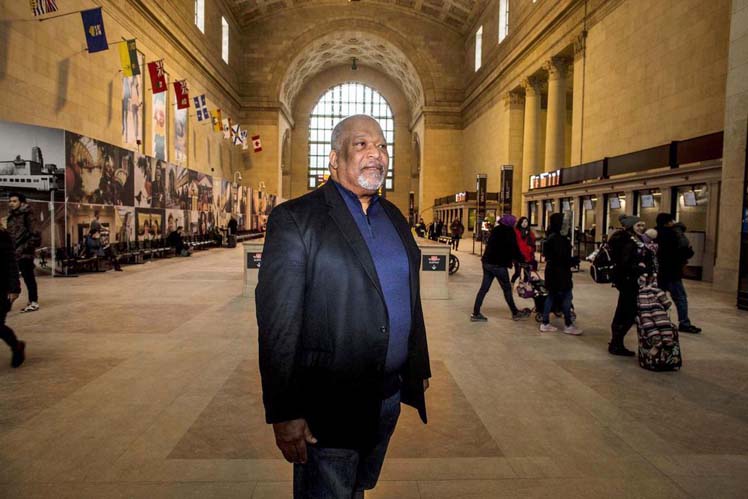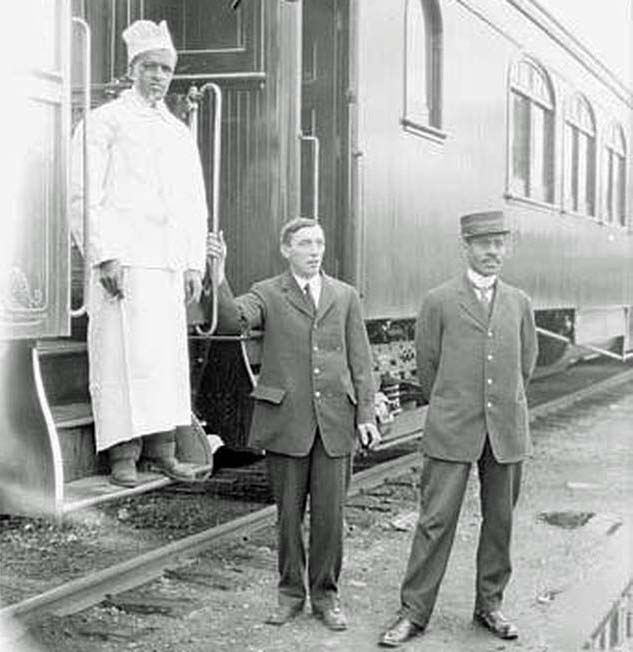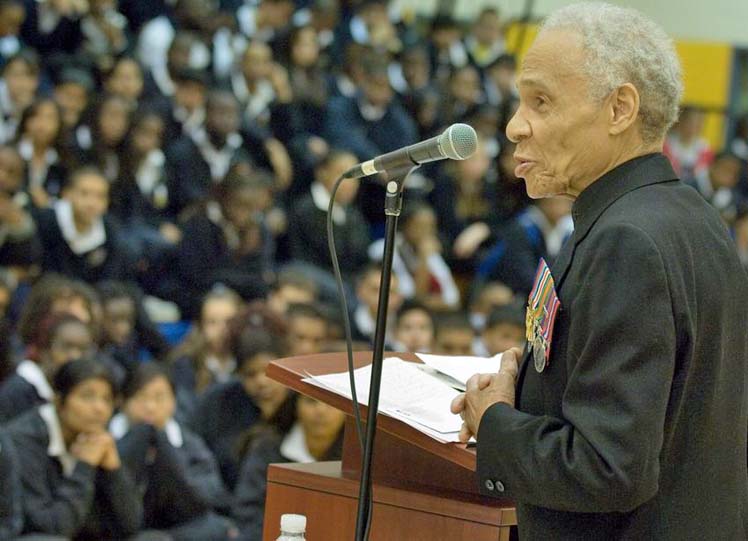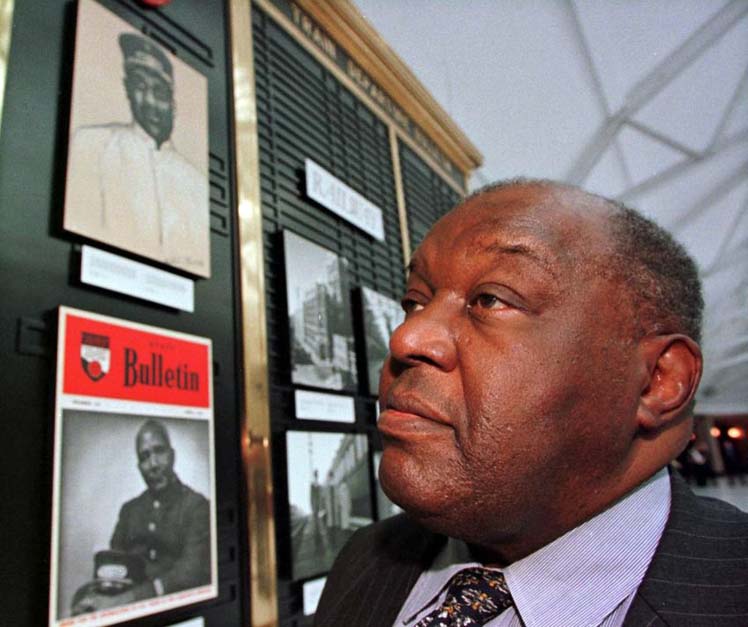
and All Called George
Canada - During the golden age of North American train travel, sleeping cars often came with porters who would carry your luggage and shine
your shoes.
Porters were smiling, courteous, and unfailingly polite, for the better part of the last century, they were also Black, male, and sometimes referred to
condescendingly as "George's boys", or simply, "George."
Both terms refer to George Pullman, a 19th-century American industrialist who pioneered and popularized a brand of train service modelled after the type of
Black servitude found in Antebellum-era plantation houses.
OKthePK Joint Bar Editor: While that may be true George Pullman was better known as the developer of the railway sleeping car.
The first Pullman porters were ex-slaves, and in Canada, where post-Confederation railway companies imported and replicated the Pullman model, Black porters
worked for decades under discriminatory conditions for minimum pay.
They were also perpetually at risk of being fired over the smallest offence.
So whenever a passenger would call a porter by the name "George", the rich, white man, to whom he was symbolically indentured, the only acceptable
response was to smile and nod.
"Most of them hated that name because it meant they had no individuality," says Cecil Foster, author of the new book "They Call Me George: The
Untold Story of Black Train Porters and the Birth of Modern Canada".
"When everyone would just simply say, hey George, get me a cup of coffee, George, clean my shoes', it meant that it didn't matter who was doing it, your
labour was indivisible. You had no identity. You were just a George."
But in his latest book, released this month by Biblioasis, Foster aims to restore the identities of the Black men who once worked on Canadian
railroads.
In the process, he also excavates a chapter of Canadian history that has been largely erased from the collective memory, the role that Black train porters
played in furthering social justice and shaping Canada into the country it is today.
In 2019, multi-culturalism is considered official government policy and equal employment rights are protected by law.
While significant challenges and inequities remain, especially for Black and Indigenous communities, the story of the Black train porter reminds us that such
ideals did not come easily to Canada, where post-Confederation leaders like Prime Minister Wilfrid Laurier envisioned a "home for whiteness in the western
hemisphere," Foster writes in his book.
"Canada wasn't originally intended to be a multi-cultural society," he writes.
"The train porters turned Canada black, brown, and a host of other shades. Yet this importance piece of Canadian history has yet to be fully
told."

1914 Photographer unknown - Library and Archives Canada.
Foster marvels at how little most Canadians know about this history, he himself only recently came to appreciate and understand it.
The journalist and academic grew up in Barbados, where he watched men leave every year to toil on North American railroads, after he moved to Canada, he worked
in several news rooms, at one point even covering the transportation beat.
He also knew the late Stanley Grizzle, a prominent labour and civil rights activist who became Canada's first Black immigration judge but worked for 20 years
as a train porter, an experience Grizzle described in his 1998 autobiography, "My Name's Not George".
Yet it was only recently that Foster pieced these fragments from his life together to realize they were all pieces of a larger story.
"I never put these elements together," he remarks.
"The truth is I only got to fully understand the impact of what these train porters did (in Canada) when I started to do the research on this
book."
In addition to interviewing surviving train porters, Foster's research involved digging through parliamentary speeches, newspaper clippings, and government
transcripts.
And while he understood that early Canada was a racist society, he was still shocked by how frequently and openly this bigotry was expressed, spanning from
1915, when politicians like Laurier casually used the n-word in Parliament, to the mid-1950s when editorials openly disdained Black
immigration.
"Nothing more disastrous could happen to Canada than an immigration flood of 5,000,000 Negroes, unless it might be a flood of 5,000,001," a national
newspaper columnist wrote in 1954.
"We wish them all well, but we do not think it would be a good thing for their numbers to be appreciably added to Canada."
Foster writes that early Canadian politicians worried about the racial turmoil they saw in the United States and strove to avoid a similar fate by suppressing
non-white and Black immigration, even though Canada was in desperate need of immigrants at the time.
The Canadian Immigration Act of 1910, for example, prohibited immigration by "anyone belonging to any race deemed unsuited to the climate or requirements
of Canada."
Foster points out that this stipulation conveniently disqualified Black people from the West Indies, who were "native to the tropics (and therefore)
deemed unsuited for the Canadian climate."
Canada preferred immigrants who were British subjects, specifically, those that were white, Foster writes.
He argues that this is why policy makers rejected pressure from Britain to allow the British West Indies to join the Canadian confederation, while Newfoundland
was allowed in.
"By keeping the Black population low, Canada's leaders argued it had avoided the racial trap that the United States had created with its dependence on
Black labour," Foster writes.
"Although Canadian policy makers eyed the British West Indies as a potential pool of cheap Black labour, fear of an increasing Black presence in the
country meant that Black immigration in the early 20th century was limited annually to 100 people, mainly men, all of whom were channelled toward a career in
portering."
Indeed, railways were one of the only work places that would hire Black Canadians, but only as porters.
Workplace segregation policies meant that Black men were never hired for operational jobs or promoted to conductors, who supervised porters.
For nearly six decades, railway employees were segregated into two groups, one for porters, nearly all of them Black, and one for all other railway employees,
who were white.
The major railway unions were no friends to the Black train porter, either.
In fact, railways used unions "to keep Blacks in their place," Foster says.
"The very constitution of the conductors' union indicated that membership had to be white," he states in his book.
"Porters on Canadian National Rail in particular would have to continue fighting their own union, the Canadian Brotherhood of Railway Employees, for
equality of treatment, and for recognition as full union members for decades."
But life would have been even harder without the limited opportunities offered by railroads and for much of the 20th century, the work of train porters became
the centre of Black life in Canada, Foster writes.
The father of former Lt.-Gov. Lincoln Alexander was a train porter, so too, was the dad of jazz legend Oscar Peterson.
In 1950s Calgary, around 90 percent of the city's Black population depended on the railways for employment, according to Foster's book.
Black train porters were always sharply dressed and the job conferred respect and prestige within their communities.
But portering was a gruelling job, involving long hours and terrible pay along with the expectation that porters would provide friendly and impeccable service
around the clock.
The risk of getting fired loomed constantly and a passenger missing his or her stop, for example, was considered a firing offence.
Porters were also vulnerable to exaggerated or false accusations, sometimes for becoming "too familiar" with white female passengers, Foster writes,
such accusations "tended to accumulate the closer the porter got to the age of retirement, an obvious attempt by the company to avoid paying
pensions."

worked 20 years as a porter - Date/Photographer unknown.
Porters were responsible for everything from serving tea and retrieving luggage to pressing clothes and shining shoes while passengers slept, an
accumulation of tasks that left porters notoriously sleep deprived.
A bitter joke was that porters were more appropriately called "sleepy car porters" rather than "sleeping car porters," Foster
writes.
In an interview with the Star, former train porter Harold Adams, 76, recalls how he slept for just 3 1/2 hours when he first started working as a porter, often
curling up on a couch in the men's washroom.
"I don't know how many times I came home and said I'm not going back, this work is not for me," he tells Foster in the book.
Adams says he never got involved with political activism but other porters, like Stanley Grizzle in Toronto, decided to organize and fight to improve the
rights of Black Canadians.
And in doing so, they played a significant role in "taking Canada off the bankrupting path of trying to be an exclusive and racist country," Foster
writes.
Black train porters like Grizzle recognized that they had to fight "both pillars of the social system, who got in and who got what work in Canada,"
he writes.
This meant advocating for fairer and more equitable employment practices, it also meant pushing Canada to change its immigration policies and expand its vision
for who could be included as "Canadians."
In his book, Foster frequently returns to a pivotal moment in 1954, when the Negro Citizenship Association chartered a sleeping car to mount a protest in
Ottawa, the first delegation of Black Canadians to meet with members of the federal Cabinet.
The group was dominated by train porters and headed by respected civil rights leader Donald Moore, whose first job in Canada was as a sleeping car porter,
Foster writes.
In their meeting with then-immigration minister Walter Harris, the delegation presented a series of grievances, challenges, and demands around Canada's
discriminatory immigration policies.
They had two broad aims, Foster writes, to challenge how Blackness and belonging was thought of in Canada, and to ensure that any benefits won by Black people
were extended to all racialized groups.

The delegation's historic trip drew national attention to Canada's discriminatory immigration laws and paved the way for change.
"These guys were smart enough to go to Ottawa and say we have a different vision for our Canada," he says.
"They said there's an alternative, and the alternative is the Canada we live in today, where even today's minister of immigration (Ahmed Hussen) would not
have been allowed in under that period."
By the late 1960s, the activism of Black train porters had yielded a series of victories that included improving their work conditions and ending policies of
workplace segregation.
In 1955, George Garraway was hired by the Canadian Pacific Railway as a conductor, making him the first Black Canadian to hold the job.
Through their own struggle for social justice, Black porters made Canada a fairer place for everyone, Foster believes.
"I'm hoping that people (who read this book) will take it as an unromanticized look at Canada, in which we look at Canada in all its warts and
imperfections," he says.
"I also hope that they will think that the Black communities were made up of exceptional Canadians, where people had a vision of what Canada could
be," he continues.
"There were those who fought for their ideas and their ideals of what a country should be, and in getting those gains, they've helped other groups achieve
those gains as well."
Jennifer Yang.
provisions in Section 29 of the Canadian
Copyright Modernization Act.

